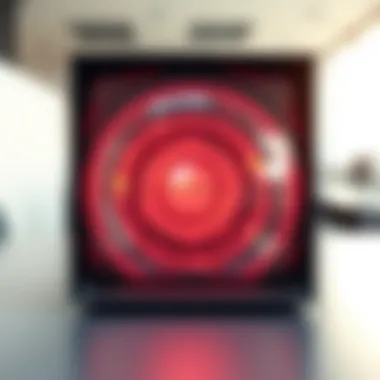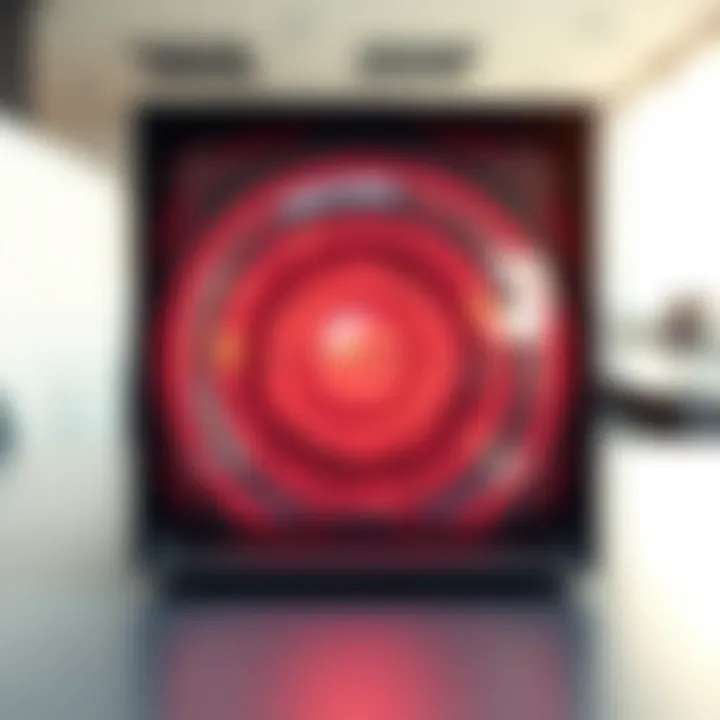Dimension Measurement Techniques in Image Processing


Intro
In today's fast-evolving technological landscape, the importance of dimension measurement cannot be understated. Image processing, an interdisciplinary field that applies various algorithms to analyze images, plays a critical role in offering accurate measurements, which are key in numerous scientific and industrial applications. With the rise of complex imaging technologies, understanding the methodologies behind dimension measurement is increasingly crucial.
What lies ahead in our exploration? We will delve into the methodologies employed in this field, such as the core principles of image processing, the common obstacles faced when measuring dimensions accurately, and the various technologies that facilitate these measurements. Furthermore, we will discuss the future research directions that could potentially bridge practical applications with theoretical advancements.
As we navigate through these components, our aim is not solely to inform but to provide a basic framework for understanding how these dimensions are gleaned from images and the tangible implications in a wide array of disciplines like engineering, medical imaging, and quality control in manufacturing. For those involved in research and development, this insight could bolster your comprehension of image processing's capability, leading to enhanced usefulness in your work. Expect a detailed analysis to follow, punctuated by thoughtful reflections on what the future might hold.
Intro to Image Processing
In today's rapidly evolving technological landscape, image processing stands as a cornerstone of modern engineering and scientific inquiry. The discipline focuses on analyzing and enhancing images, enabling practitioners to extract vital information and make more informed decisions across various fields. With the rise of digital image acquisition, the significance of image processing has grown exponentially. It's not just about manipulating pixels for aesthetic purposes; it's about harnessing visual data to drive innovation, improve efficiency, and solve complex problems.
For this article, we emphasize the importance of understanding image processing—particularly as it pertains to dimension measurement. Accurate measurements derived from images can lead to enhanced precision in applications ranging from healthcare to manufacturing. Thus, exploring image processing is essential for anyone looking to optimize measurement techniques through modern technology.
Definition and Importance
Image processing refers to the manipulation and analysis of images through algorithms and computational techniques. The importance of this field cannot be overstated: it serves as a bridge between raw data captured by cameras and actionable insights. This is not merely a technical pursuit; it is foundational in domains such as remote sensing, robotics, and medicine, where dimensional accuracy can significantly influence outcomes. For instance, medical imaging technologies depend on image processing to visualize tumors in three-dimensional space, impacting treatment options and patient survival rates. Therefore, understanding the nuances of image processing is crucial when tackling measurement challenges.
Historical Context
The roots of image processing can be traced back to the 1960s, when scientists like Lawrence Roberts began exploring the possibilities of computer-enhanced images. The journey from black and white photographs to the sophisticated imaging technologies available today has been marked by significant milestones; from early techniques such as linear filtering to the more complex machine learning algorithms of today. Knowing the history of this field helps appreciate the current advancements and their impact on dimension measurement. Each technological leap—from the introduction of the first digital cameras to the rise of machine learning—has expanded our capabilities to analyze and measure dimensions accurately, paving the way for modern applications.
Applications in Science and Industry
Image processing finds applications in a myriad of fields, especially where precision is paramount. Here are a few major domains where it plays a transformative role:
- Healthcare Imaging: Techniques like MRI and CT scans employ image processing to generate detailed anatomical images, enabling practitioners to diagnose conditions more accurately.
- Manufacturing: Quality control processes use image processing to monitor manufacturing outputs, identifying defects more effectively than human inspection.
- Environmental Monitoring: Remote sensing applications utilize processed images of Earth's surface to gather data on climate patterns and resource management.
These examples barely scratch the surface of how image processing facilitates enhanced dimension measurement, showcasing the multifaceted benefits that evolve from mastering this discipline. >This versatility illustrates the reality that accurate dimension measurements are crucial not only for precision but also for compliance and efficiency in operations across sectors.
In summary, the relationship between image processing and dimension measurement is not a mere academic exercise but a vital intersection of technology and practical applications. Understanding how image processing stands to enhance measurement techniques prepares students, researchers, educators, and professionals alike to embrace advancements that could redefine their fields.
For more intricate insights into image processing and its effects, resources like Wikipedia provide a wealth of information, while platforms like Britannica delve deeper into historical context and applications.
Fundamentals of Measurement Techniques
Understanding measurement techniques is foundational to the field of image processing, especially when it comes to deriving accurate dimensions from images. Measurement, in essence, is about quantifying physical entities, and when it intersects with image processing, it becomes an intricate dance between capturing visual data and extracting meaningful insights from that data. The importance of rigorous measurement techniques cannot be overstated; they ensure that the information we derive is not only reliable but also applicable across various disciplines, including engineering, healthcare, and environmental science.
The core benefits of mastering measurement techniques are manifold. First, precise measurements enable enhanced decision-making processes in various domains. Engineers designing machinery, for instance, must rely on accurate dimensioning to avoid catastrophic failures. In a healthcare context, accurate imaging can lead to better diagnostics and treatments. Additionally, when measurement techniques are standardized, they promote interoperability between different systems and tools, ensuring consistency in results.
Ultimately, the effective application of measurement techniques in image processing involves a multifaceted approach that considers the principles of imaging, the characteristics of the objects being measured, and the calibration methods used. A grasp of the fundamentals sets the stage for understanding more complex concepts that follow.
Basic Measurement Concepts
When delving into basic measurement concepts, the foundation lies in understanding what exactly we aim to achieve. Measurement can be defined as the process of obtaining the magnitude of a quantity. In the realm of image processing, this often translates into quantifying lengths, areas, or even volumes derived from two-dimensional images. The units of measure can vary significantly based on the domain—millimeters in manufacturing versus pixels in digital images.
At its core, the process involves several key elements:
- Reference Points: Defining starting and ending points for measurement is crucial in obtaining precise values. Without clear reference, measurements risk ambiguity.
- Scale: Establishing a scale, often from a known reference object within the image or through calibration, can clarify how the captured data translates into real-world metrics.
- Technique Selection: Knowing which technique to apply, be it pixel counting or edge detection, can impact the quality of measurements.
- Error Margin: Every measurement will have a degree of uncertainty, and acknowledging this margin is critical in ensuring robustness in findings.
Geometric Properties in Images
Geometric properties profoundly influence the accuracy of dimension measurements. They refer to the shapes and forms of objects captured in images and can provide integral data about size and orientation. In image processing, the focus lies on identifying and analyzing various geometric elements such as points, lines, and surfaces.
For commencement:
- Shape Representation: Different shapes will project differently in digital images. The aspect ratio, corners, and contours all dictate how effectively we can measure dimensions.
- Orientation and Positioning: Knowing how an object is oriented within an image can significantly affect measurements. For example, a circular object at an angle may appear elliptical, misleading measurements if the orientation is not accounted for.
- Symmetry and Regularity: Regular and symmetric shapes, like circles or squares, typically yield simpler calculations compared to irregular forms, which may require more complex analysis to derive accurate dimensions.
Calibration Methods
Calibration is the bedrock of reliable image measurements. It refers to the process of correlating the measurement output from an imaging system to known standards. Without proper calibration, measurements can become skewed and unreliable.


Common calibration methods include:
- Fixed Reference Calibration: This involves using objects of known measurements juxtaposed against the target being analyzed. By comparing these standards, systems can adjust their readings.
- Software-Based Correction: Many software tools incorporate algorithms designed to correct for systematic errors, enhancing measurement fidelity.
- Multi-Point Calibration: This technique involves taking multiple measurements across a range of conditions to create a calibration curve, ensuring greater accuracy across different scenarios.
In summary, mastering measurement techniques is a vital part of harnessing the full potential of image processing for accurate dimension measurement. These concepts not only form a technical foundation but also help positioning practitioners to innovate and improve existing methodologies, whilst addressing the challenges presented by varying environments and requirements in analysis.
"Accurate measurement is the cornerstone upon which reliable data analysis stands."
For further reading on measurement techniques and their applications, visit resources like Wikipedia, Britannica and relevant discussions on Reddit.
By keeping these fundamental aspects of measurement techniques in mind, professionals and researchers can navigate the field of image processing with greater confidence and expertise.
Image Processing Techniques for Dimension Measurement
When it comes to extracting measurements from images, possessing the right techniques is more than just crucial—it’s essential. Image processing techniques offer a way to not only enhance images but also to decipher vital dimensions lurking in the pixels. These methods will help in achieving a level of precision that traditional measurement methods often fall short of, especially in environments where manual measurements can lead to errors. The following techniques include edge detection algorithms, thresholding techniques, and morphological processing, each contributing distinctly to the endeavor of dimension measurement.
Edge Detection Algorithms
Edge detection algorithms stand as fundamental tools in image processing. They work by identifying and locating sharp discontinuities in an image, which correspond to boundaries of objects or changes in color and texture. The importance of edge detection cannot be overstated, especially in dimension measurement, where precision is the name of the game.
One popular edge detection method is the Canny algorithm, which is favored for its ability to detect edges with high accuracy. The Canny method involves several steps: smoothing the image to reduce noise, finding intensity gradients, applying non-maximum suppression, and using double thresholding. This layered approach enables the algorithm to deliver clean and precise edge maps—critical for accurately gauging dimensions.
"In many image analysis scenarios, the quality of edge detection significantly impacts the reliability of subsequent measurement outcomes."
Other algorithms like Sobel and Prewitt also come into play. While these algorithms may not match the precision of Canny, they have their own advantages such as computational efficiency. Choosing the right algorithm often hits on the specific requirements of the project at hand.
Thresholding Techniques
Thresholding techniques serve as a bridge between raw image pixels and meaningful dimension data. Essentially, they transform a grayscale image into a binary image—where each pixel is scaled down to either black or white based on a threshold value. This is immensely useful as it simplifies the image, making it easier to isolate objects of interest.
Two common methods are global thresholding and adaptive thresholding. Global thresholding uses one threshold value for the entire image, while adaptive thresholding computes threshold values for smaller regions of the image, which is especially useful in situations where lighting conditions are uneven or when the objects of interest vary considerably in color.
The effectiveness of thresholding lies in its ability to facilitate measurement by simplifying the analysis process. Without proper thresholding, distinguishing between various dimensions and objects can become a convoluted task. Thus, having a grip on various thresholding methods equips researchers and professionals to handle a variety of imaging challenges.
Morphological Processing
Morphological processing may sound intimidating, but it's all about the shapes and forms within an image. This technique often analyzes how different pixel shapes interact with each other and helps refine the structures that become evident after edge detection and thresholding. It often comprises operations like dilation, erosion, opening, and closing.
Dilation adds pixels to the boundaries of objects in the image, which can help in bridging gaps between disconnected components—making it easier to measure continuous shapes. On the other hand, erosion removes pixels from the edges of objects, which is especially useful for eliminating noise and small artifacts brought about in earlier processing stages.
The final output from morphological operations can lead to clearer shapes that lend themselves better to direct measurement, reducing ambiguity that may arise from raw image data.
In sum, these image processing techniques—edge detection algorithms, thresholding techniques, and morphological processing—are indispensable assets in the realm of dimension measurement. They not only enhance the accuracy of measurements but also streamline the overall analytical process. To delve deeper into such techniques, one can explore resources like Wikipedia's Image Processing or Britannica's Visual Communication.
Understanding and mastering these methods holds the potential to open new doors in various fields, ranging from healthcare imaging to manufacturing processes—where each measurement can carry significant implications.
Challenges in Accurate Dimension Measurement
In the realm of dimension measurement through image processing, challenges abound. These obstacles can impede the accuracy and reliability of measurements, directly affecting outcomes across various applications, from healthcare to manufacturing. Understanding these challenges not only heightens comprehension of the topic but also aids in identifying suitable solutions to improve measurement precision.
Image Quality Factors
When it comes to image processing, some might say that the devil is in the details. The quality of the images used plays a pivotal role in how accurately dimensions are determined. For instance, images that are blurred or low in resolution can lead to misinterpretation of edges and contours, skewing the results. Factors such as lighting conditions, contrast, and noise can also impact image sharpness and clarity.
- Resolution: Higher resolution images capture more details. Conversely, a grainy image can obscure critical features, making it harder to calculate dimensions accurately.
- Contrast: Adequate contrast between the subject and its background is vital. A lackluster contrast may result in difficulty differentiating between edges, complicating measurements.
- Noise: Whether it's electronic noise from the camera or environmental disturbances, noise can introduce inaccuracies. Effective noise reduction techniques are crucial in optimizing image quality.
When assessing images, applying preprocessing techniques like filtering can help improve quality. This ensures that measurements drawn from such images will stand up to scrutiny.
Environmental Influences
The environment in which an image is captured can significantly affect measurement precision. Conditions like temperature, humidity, and even atmospheric pressure can change the properties of materials being measured, leading to slight errors during analysis. For instance, thermal distortion can alter an object's shape under different temperatures, causing variations in measurement.
Some specific environmental factors include:


- Lighting Variability: Inconsistent lighting can lead to reflections or shadows that misrepresent the actual dimensions.
- Surface Conditions: An object’s texture can impact the way light interacts with it, which can obscure edges or create misleading representations.
- Camera Positioning: The angle from which an image is taken can affect depth perception. Ensuring a perpendicular angle minimizes projection errors, especially for three-dimensional objects.
Recognizing these influences empowers researchers and professionals to better control their imaging environments and ultimately leads to higher accuracy in their dimensions.
Limitations of Current Technologies
Despite significant advances in image processing technology, limitations remain that can thwart accurate dimensions measurement. While tools and software have evolved with complexity, they are not without their faults. Some major limitations include:
- Software Limitations: Many programs may overlook certain nuances in image data, primarily due to algorithmic constraints. This can lead to oversimplified analysis.
- Processing Time: High-resolution images may require intense computational resources. This can lead to delays, and when results take time, the risk of altering conditions increases.
- Human Error: As with any technology, human interaction is crucial. Misinterpretation of software results or improper application of techniques can lead to flawed measurements.
Ultimately, acknowledging the limitations inherent in current technologies allows professionals to explore alternatives or enhancements, aiming to push the boundaries of what’s presently achievable.
"The journey through dimension measurement is paved with both opportunities and challenges. Navigating this landscape requires adaptability and a proactive approach to overcoming obstacles."
Software and Tools in Image Processing
The realm of image processing is vast, and within it lies a critical component: software and tools. They are the lifeblood that drives the efficacy of dimension measurement techniques, serving as the vessels through which complex algorithms translate raw images into valuable data. Understanding the landscape of software options not only informs one’s choices but also enhances the accuracy of measurements, ultimately benefiting fields as diverse as healthcare, manufacturing, and environmental science.
Open Source Versus Proprietary Software
When selecting software for image processing, the debate between open source and proprietary options often comes up. Open source software, like ImageJ or OpenCV, offers flexibility and customization at little to no cost. This can be particularly appealing for academic researchers or small startups with limited budgets. Both have thriving communities that contribute to ongoing improvements and provide peer support. Some advantages of open source software include:
- Cost-effectiveness: Most open source tools are free, removing financial barriers.
- Flexibility: Users can modify the source code to suit their needs, allowing for custom solutions.
- Community-driven: Regular updates and enhancements come from a dedicated group of developers and users.
On the flip side, proprietary software, such as MATLAB or Adobe Photoshop, usually provides comprehensive support and a user-friendly interface. Here, users might pay more upfront, but they often gain:
- Robust Customer Support: Vendors offer professional assistance and troubleshooting.
- Integration Features: Proprietary tools often boast excellent compatibility with other industry-standard software and hardware.
- Advanced Functionality: These programs usually come packed with high-end features tailored for specific applications.
Ultimately, the choice hinges on individual needs, available resources, and the specific requirements for dimension measurement within a given context.
Image Analysis Software
Image analysis software plays an essential role in streamlining the process of dimension measurement. It uses advanced algorithms to extract quantitative information from images. For instance, software such as Fiji or CellProfiler is designed specifically for biological image analysis, helping researchers measure cell dimensions or assess morphology. Here’s what characterizes effective image analysis software:
- User-Friendly Interfaces: The most effective tools simplify complex processes, making them accessible even for those with limited programming knowledge.
- Algorithm Availability: Comprehensive libraries of algorithms facilitate various operations, from Image Segmentation to edge detection. This diversity allows adaptability to different measurement scenarios.
- Interoperability: Many tools can integrate with other platforms, enhancing data sharing and analysis capabilities across different research areas.
"The right image analysis software can significantly reduce errors and improve the quality of dimension measurement outcomes."
Choosing the right image analysis software not only maximizes the precision of measurements but also enhances repeatability and reproducibility in research.
Future Software Trends
As technology advances, the landscape of image processing software continues to evolve. Some emerging trends indicate how dimension measurement techniques may transform in the coming years:
- Artificial Intelligence Integration: Machine learning models are increasingly being employed to automate and enhance image analysis processes, leading to faster and more reliable measurements.
- Cloud Computing: Storing and processing data in the cloud allows for quicker computations and easy access, making collaborative projects simpler to manage.
- Real-time Analysis: With improvements in processing power, future software may enable real-time measurements, which could be a game-changer in fields like surgery or automated quality control in manufacturing.
Practical Applications of Dimension Measurement
Whether it's in healthcare for diagnostics, manufacturing for quality assurance, or environmental monitoring for data collection, the implications of image processing are profound. Not only does it provide a streamlined way to obtain critical measurements, but it also greatly enhances precision and reduces human error. The following sections will delve into the specifics of dimension measurement in these sectors, highlighting its significance, benefits, and practical considerations that must be addressed.
Healthcare Imaging
In the realm of healthcare, accurate imaging is a cornerstone of effective diagnosis and treatment. Dimension measurement through image processing aids in various medical applications, notably in radiology and pathology. For example, determining the size of tumors or other abnormalities is crucial for assessing their progression and deciding on treatment plans. Traditional measurement methods may involve manual techniques, which are not only time-consuming but can also lead to variabilities due to human error.
With the use of advanced image processing techniques, practitioners can swiftly extract measurements from medical images such as MRIs and CT scans. "When dimensional accuracy is essential in deciding a treatment, the role of precise measurement through imaging cannot be overstated," says Dr. Elise Tran, a radiologist. The implementation of automated image analysis tools enhances not only the speed of analysis but also the reliability of the measurements obtained. As a result, patient care is improved, and health outcomes are more favorable.
Manufacturing Processes
Dimension measurement in manufacturing is all about quality control and efficiency. In industries like automotive and aerospace, the tolerances for dimensions are incredibly tight. A minuscule error can lead to significant issues in safety and performance. Here, image processing technologies come into play, enabling manufacturers to monitor and verify dimensions of components with unparalleled accuracy.
Consider a scenario where a manufacturer needs to confirm the dimensions of a part before it moves to the next stage of production. By employing automated vision systems to conduct measurements, companies can expect significant reductions in scrap rates and rework costs. Moreover, the speed at which measurements can be taken means that production lines can maintain high throughput without compromising quality. This synergy of speed and accuracy is vital in today's fast-paced manufacturing landscape.
Environmental Monitoring


Environmental monitoring is another area where dimension measurement through image processing proves its worth. Understanding the dimensions of environmental features, such as the breadth of riverbanks or the height of vegetation, is essential for effective resource management and conservation efforts. Image processing facilitates the analysis of aerial images or satellite data, allowing researchers and policymakers to extract valuable information.
For instance, by applying specific algorithms, scientists can delineate various physical features and calculate surface areas or volumes necessary for studies related to climate change. This data becomes invaluable in decision-making processes aimed at mitigating environmental impacts.
Additionally, as the demand for real-time monitoring continues to grow, the integration of image processing in such contexts becomes increasingly vital for ensuring informed and timely interventions.
"The future of environmental management lies in our ability to harness dimensions from the visual data we collect," states Dr. Nina Forsyth, an environmental scientist.
Case Studies in Dimension Measurement
Case studies in dimension measurement play a crucial role in illustrating the real-world applications and effectiveness of image processing techniques. By examining various scenarios where these methods have been implemented, we can highlight specific elements that contribute to their success. Moreover, these studies showcase both the advantages and the challenges that practitioners face when utilizing image processing for precise measurement.
In the context of this article, case studies serve as vital learning tools. They allow students, researchers, and professionals to see, in practical terms, how theoretical concepts come to life. The examination of successful implementations can foster innovation and inspire new methodologies by revealing insights that might be overlooked in purely academic discussions. Now let’s delve into three distinct case studies that spotlight the versatility of dimension measurement through image processing.
Case Study One: Medical Imaging
Medical imaging significantly benefits from dimension measurement techniques. As technologies like MRI and CT scans grow more advanced, accurate dimensional assessments become essential for diagnosing and treating patients. Image processing algorithms are employed to segment anatomical structures, allowing for precise volumetric measurements. An example would be measuring the size of a tumor in relation to surrounding tissues. This information can greatly influence treatment plans and surgical approaches.
Techniques such as edge detection and morphological operations enhance the clarity of medical images. They allow healthcare professionals to not only identify abnormalities but also quantify their dimensions effectively, which is critical in the healthcare decision-making process. Challenges in this realm often arise from noise in images and variability in anatomical features. However, ongoing research aims to improve image quality and analysis, ensuring that measurements are as accurate as possible, ultimately benefiting patient outcomes.
Case Study Two: Industrial Inspection
In industry, accurate dimension measurement ensures the quality and safety of products. For example, automotive manufacturing utilizes image processing to check the dimensions of parts during production. A slight deviation from standard specifications can lead to failures down the line. Thus, having systems in place that can automatically measure and verify dimensions in real-time increases efficiency and reduces waste.
Techniques like thresholding and spatial filtering are often applied here. These allow for quick defect identification and dimensional analysis without manual intervention. This not only streamlines the inspection process but also ensures that quality control remains tight. Issues such as lighting conditions and reflective surfaces can pose challenges during inspections. Nonetheless, advances in image processing capabilities continue to address these problems, making inspections faster and more reliable.
Case Study Three: Remote Sensing
Remote sensing is another arena where dimension measurement proves invaluable, especially regarding environmental studies. Satellite imagery, for instance, is used to monitor various landscape features like forests, rivers, and urban areas. Measuring these features accurately affects understanding and management of natural resources, urban planning, and disaster response.
Image processing techniques allow scientists to analyze spatial data effectively. By employing methods that enhance image quality and extract relevant dimensions, researchers can assess changes over time, such as deforestation rates or urban sprawl. Yet, the geographic factors can complicate analysis, leading to challenges in measurement accuracy. Still, continuous developments in algorithms enhance the precision with which dimensions can be captured from satellite imagery, offering insights critical to environmental management.
In these case studies, it is evident that across diverse fields, image processing plays an instrumental role in dimensional measurement, shaping outcomes that range from healthcare solutions to industrial quality control and environmental monitoring.
To sum up, the depth and variety of case studies illustrate the multifaceted applications of dimension measurement through image processing techniques. By exploring these examples, we see how crossing theoretical boundaries into practical applications can foster innovation and improvement across multiple sectors.
Future Directions in Dimension Measurement
As technology continues to sweep through industries at an impressive pace, the field of dimension measurement via image processing stands to gain tremendously. This section highlights how advances in various sectors can transform the methodology used for precise measurements, solidifying their significance in both scientific research and practical applications. With an unyielding gaze toward the future, we shall delve deep into innovative techniques, interdisciplinary approaches, and potential research areas.
Innovative Techniques
In recent years, a notable surge in innovative techniques has reshaped how measurements are obtained through image processing. These methods not only enhance accuracy but also expand the realms of possibility for different domains. For instance, utilizing deep learning models allows for a more refined edge detection process. When combined with convolutional neural networks, these models can significantly improve measurement precision by intelligently recognizing patterns that traditional techniques might miss.
Moreover, the advent of 3D imaging technologies has opened new avenues in understanding dimensionality. Techniques such as volumetric measurement using stereoscopic imaging can generate three-dimensional reconstructions from two-dimensional images. This provides a richer dataset that can yield more reliable results in complex scenarios, like assessing surfaces in manufacturing or mapping in natural environments. The employment of drones equipped with high-resolution cameras also enables large-scale data acquisition for terrain or structural analysis— dimensions can be easily calculated in real-time through processed images.
Interdisciplinary Approaches
The need for interdisciplinary approaches in dimension measurement cannot be understated. Collaborating with experts in fields such as computer vision, robotics, and material science leads to a more holistic understanding, which can drive innovation. For example, combining insights from biology with engineering principles has resulted in biomimetic designs that improve measurement tools.
One specific area of fruitful collaboration is in healthcare imaging. By merging medical expertise with advanced image processing, ways to measure tumor dimensions with unparalleled accuracy have emerged. Such efforts not only help in diagnosing but also in monitoring treatment efficacy. Integrating the arts can also be informative. Designers use measurement processes for visual storytelling, emphasizing the relationship between art and science.
Potential Research Areas
- Sensor Integration: Developing smart sensors that work in tandem with image processing to provide more accurate dimensional data in real-time.
- Real-time Processing: Advancing algorithms that can process images dynamically allows for faster and more efficient measurement systems, crucial in areas like surgical navigation.
- Artificial Intelligence: Exploring AI's role in automating the measurement process. Intelligent systems can learn from vast datasets and improve their measurement accuracy without constant oversight.
- Environmental Considerations: Investigating how environmental factors impact measurements and discovering adaptive strategies to mitigate these effects.
"The future of dimension measurement lies not only in technological advancements but also in fostering synergies across diverse fields of knowledge."
Finale
As we wrap up this exploration of dimension measurement through image processing, it’s evident that this topic holds significant relevance in a myriad of fields. The importance of understanding and mastering these measurement techniques cannot be overstated, especially when accuracy and precision can make or break an outcome in fields ranging from healthcare to engineering.
One of the core elements we discussed involves advanced methods that allow researchers to extract invaluable information from images. This capability is not just about numbers; it’s about enhancing the quality of results and making informed decisions based on robust data. For instance, in medical imaging, being able to measure dimensions with high accuracy can lead to better diagnostic outcomes, tailoring treatment plans that cater to individual patient needs. Furthermore, figuring out dimensions accurately in manufacturing processes significantly minimizes waste and boosts efficiency, ultimately translating to higher profitability.
Nevertheless, it's important to acknowledge the complexities that accompany these technologies. The potential pitfalls, stemming from environmental factors or limitations in current methods, highlight a need for continuous improvement and research in this area.
The future directions we’ve hinted at throughout our conversation illustrate a landscape where interdisciplinary approaches could play a pivotal role in refining these measurement strategies. By embracing innovations and keeping an eye on new potential research areas, those involved in image processing can push boundaries further.
Overall, the conclusion of our examination reiterates that dimension measurement via image processing is a cornerstone technology, opening doors for advancements that will shape not just academic research but practical applications that have real-world benefits. This journey through the nuances of the topic is just the start; the horizon is wide, and the possibilities are endless.







